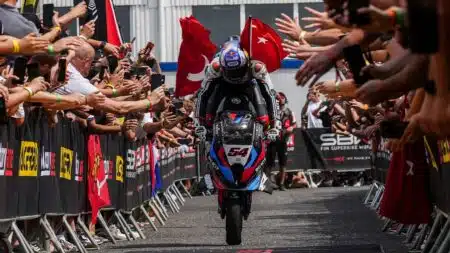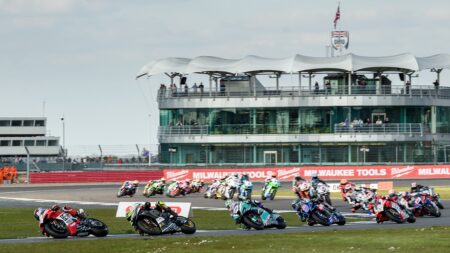
'How racing should be' – Is British Superbikes motor sport's most exciting series?
The 2025 British Superbikes finale is this weekend at Brands Hatch. Is its competition unrivalled? James Elson speaks to some of its top riders to find out
Personally, I hate all new technology, without exception. Well, except anything that allows me to be lazier than I already am.
So, yes, I will grudgingly admit that new technology can be a wonderful thing, when it works. At Estoril last weekend there were two fascinating instances of new technology not doing the right thing.
In the race Nicky Hayden’s electronics went berserk, giving him one of the scariest rides of his career. Apparently his Ducati GP12 got lost – it suffered a GPS glitch so it didn’t know where it was on the racetrack.
When Hayden was at Turn One his GP12 thought it was at Turn Four and when he was on the brakes the traction control was cutting in. Maybe the bike thought it was back home at Mugello or perhaps the satnav in his crew’s rental car had confused the GPS so the bike was trying to find its way back to the team’s hotel.
“It was quite dangerous, especially at the last corner,” said the American. “When I opened the throttle there all of a sudden I’d lose power, the weight distribution would change and I’d almost lose the front.”
Surely this is a sign that electronics have gone far too far in MotoGP? Most of the riders agree. They want the control in their hands, not in a little black box. Riders like Hayden, Casey Stoner, Ben Spies and Valentino Rossi all agree they’d prefer less electronics.
Maybe now is the time to start restricting the technology, creating traction control systems that are designed purely to improve safety rather than enhance performance. Banning onboard GPS – which allows the bike to adjust throttle response, traction control, engine braking and so on for each individual corner – might be a good place to start.
The other example of technology doing bad things at Estoril occurred in the media centre, of all places.
Like all technology, the internet is amoral. Like nuclear power it can be used for good or for ill. In the media world it increases pressure on journalists to come up with attention-grabbing headlines. Instead of needing one big headline a day or one big headline a week, there’s pressure to come up with a big headline every few hours. Thus the temptation to not let the facts get in the way of a good story increases several fold.
So it was last week with the Casey Stoner retirement headlines. This story appeared first on a Spanish website and then in the Spanish press. It grew from the revelation – leaked to the press by Repsol Honda management – that Stoner had turned down the offer of a new two-year contract for 2013 and 2014. (There is a Machiavellian sub-text to this revelation which I can’t be bothered to go into here.) Instead the reigning MotoGP champ told his employers that he would prefer a one-year contract.
Some journalists took this information and ran with it – speculating that Stoner was already considering retirement. Nonsense, of course.
Top riders often prefer one-year deals because it keeps them more in control of the situation. Other riders concerned about their future potential are more likely to want the added security of a two-year contract. Stoner’s childhood hero Mick Doohan often preferred one-year deals. It allowed him to renegotiate more often and usually in his favour. It also allows the rider more flexibility in case things change, either with his employers or at a rival factory.
Inevitably the subject of Stoner’s ‘retirement’ came up during a press conference at Estoril. The man in the spotlight treated the rumours with disdain.
“Everyone in MotoGP seems good at making up stories,” he said. “I’ve said many times I’m not going to have a long career and at the moment I haven’t decided what I’m doing next year. But until you hear it from my mouth – don’t believe what you read. I’m certainly not thinking about retirement at this point.”
When one of the journalists who had splashed the retirement story on his front page asked Stoner a question, the Aussie looked him straight in the eye and said “Don’t read what you produce”.
It was a genius put-down and reminiscent of Doohan in his glory days. Doohan took no prisoners in his dealings with the press and struck terror into many journalists who crossed him. On one occasion he reduced a journalist to tears with a scornful reply to a stupid question.
I well remember his reply to another journalist, who had dared to express doubt about something Doohan had said. “Are you calling me a liar?!” asked the five-time 500 World Champion.
Then there was the press conference – in Argentina, I think – during which he tired of a local journalist’s persistent line of questioning. Doohan clammed up and reverted to WW2-style name-rank-and-number replies. “My name is Mick Doohan and I am competing in the Argentine Grand Prix for the Repsol Honda team,” he said with one of his scary glares.
Of course, it’s not impossible that Stoner might retire at the end of next year. He’s already said that he won’t stick around long enough to emulate Doohan’s five titles and he makes no secret of the fact that he’d much rather be home on the family farm in New South Wales, making babies, hunting wild pigs and thrashing around on dirt bikes than endlessly circulating the globe. At the some point the joy of racing the world’s trickest motorcycles will be outweighed by the ennui of aeroplanes, hire cars and hotel rooms. It happens to every racer eventually.
This is four-time 500 champ and home-loving Californian Eddie Lawson on the subject. “I hated the travelling so much. That last year [1992] I’d sit at home, thinking about going to Europe, thinking ‘I can’t get out of the chair to go’. When you’re young the travelling is okay, but I’d had ten years doing 50 international flights a year. I’d had enough.”
This year is Stoner’s 11th season of Grand Prix racing.

The 2025 British Superbikes finale is this weekend at Brands Hatch. Is its competition unrivalled? James Elson speaks to some of its top riders to find out

Toprak Razgatlıoğlu is the most exciting motorcycle racer on Earth right now, so what’s his riding technique and will it work in MotoGP? The Turkish World Superbike genius talks stoppies, breakdancing, riding MotoGP bikes and why he needs engine-brake more than anything

This year’s British GP will feature two BSB Superstock races, with the aim of staging BSB Superbike races in 2025. Plus Silverstone boss reveals what it’s like dealing with Liberty Media, MotoGP’s new owners

Racing is in thrall to the cult of youth but the death, earlier this month, of nine-year-old motorcycle racer Lorenzo Somaschini has prompted Matt Bishop to ask whether higher minimum age limits should be imposed